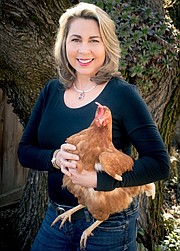Planning and Planting for the Fall Vegetable Garden
CANDACE GODWIN/Growing in North Idaho | Coeur d'Alene Press | UPDATED 1 year, 6 months AGO
With our summer gardens growing and producing in full force, it’s hard to even think about planning or even planting a vegetable garden for fall. But now is the time to do so.
Our region’s growing season for warm-season crops is relatively short, however, many of spring’s cool-season crops can make a second appearance in the fall garden. These include vegetables such as lettuces and hardy greens, peas, carrots and beets, leeks and bunching onions and brassicas.
When planning the fall garden, it’s important to select cool-season crops that will mature within 60 days or less. Keep in mind that summer’s daylight hours are receding and because of this you should add an additional two weeks to the plant’s “days to maturity” listed on the seed packet. Also, select cool-season vegetables that can tolerate a light frost, like spinach and kale. These crops taste even sweeter after a touch of frost.
To ensure a successful fall harvest, cool-season crops should be sown by mid-July and transplanted into the garden by early August. In our region, it’s difficult to find cool-season transplants at garden centers in the heat of summer, so it’s best to start crops from seed in growing modules or direct-sow the seed into the garden.
Starting seeds now provides enough time and daylight for the crops to become established and produce a harvest. Young seedlings can be interplanted between summer crops, which will provide shade for the cool-season varieties during the heat of summer.
Remove any spring or summer crops that are waning in production or have finished producing to prepare the fall garden. Clear out any weeds as well. A side-dressing of compost can be placed around newly transplanted seedlings for a nutritional boost.
Cool-season crops need cool soil, so mulching is critical. Once your seedlings are transplanted or direct-sown seeds have emerged, apply a layer of mulch around the plants. An added bonus of mulch — it also helps suppress weeds. Chopped straw, pine needles, leaves, or grass clippings will do the job, but avoid any mulch material that contains herbicides.
Not sure what to plant? Here are a few great choices to get you started:
Lettuces: Choose loose-leaf, cut-and-come again varieties like Lolla Rossa, Merlot, Marvel of Four Seasons, or Buttercrunch; all mature in about 45 days.
Hardy Greens and Brassicas: Any variety of arugula, spinach, chard, Asian greens, kale, mustards and spouting broccoli will shine in the fall garden. Baby leaves can be harvested in as few as 30 days. Most of these crops are frost-tolerant and will taste better after frost.
Root Crops: Radishes, beets, carrots and bunching onions can also be started now. Most radishes mature around 30 days, so you can do a succession planting every week and have radishes right through the fall. Choose early varieties of beets, like Early Wonder (50 days) and beet greens in fall salads. The green tops of bunching onions are ready in about 30 days. Select true “baby” carrot varieties that mature in about 50 days. When mulched properly, carrots will store in the ground into winter.
Herbs: Did your cilantro seem to go from seedling to seed this summer? Cilantro is a cool-season crop and will quickly bolt in summer’s heat. Sow this herb now for a fall crop, just in time for making salsa!
Summer’s end doesn’t mean that the garden has to stop producing. On the contrary, planning for and planting, a fall garden extends our short summer growing season and delivers fresh produce into October and even through the first frost.
Candace Godwin is a Certified Idaho Master Gardener. The University of Idaho Extension, Kootenai County Idaho Master Gardener program is located in the UI Research Park, 958 S. Lochsa St., in Post Falls. Learn more about us at https://www.uidaho.edu/extension/county/kootenai/garden or on Facebook. Visit us in person, email us at kootenaimg@uidaho.edu, or call us at (208) 292-2525. IMG services are free to the public.







